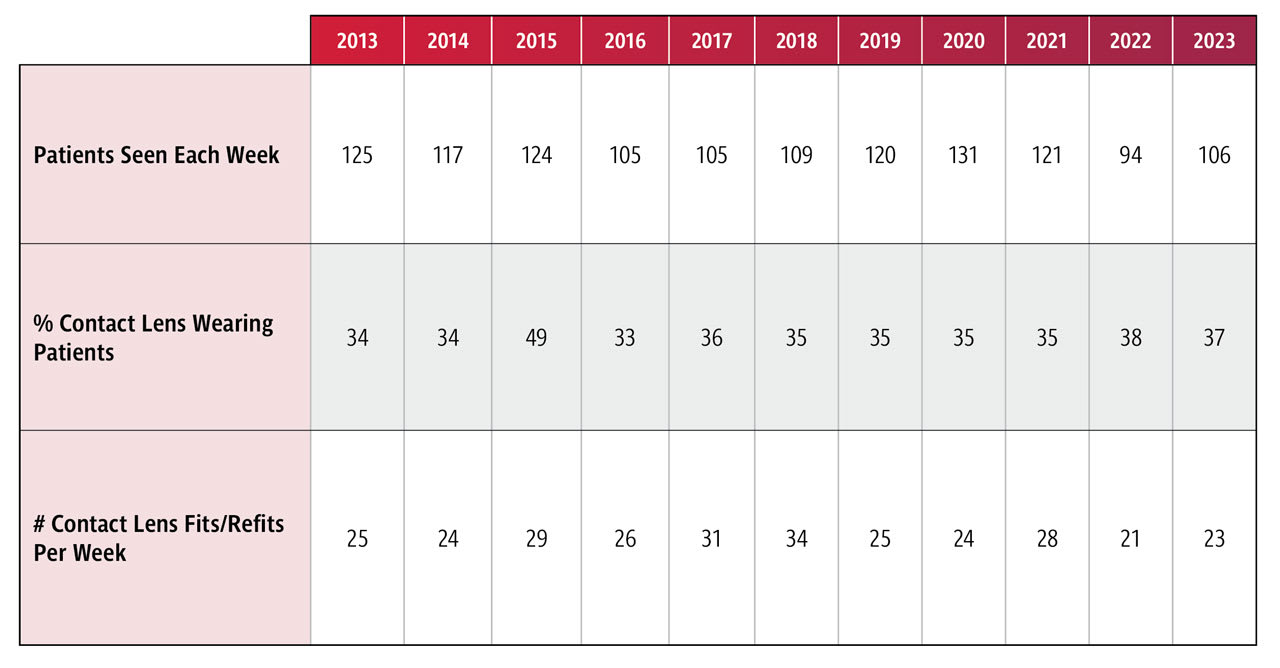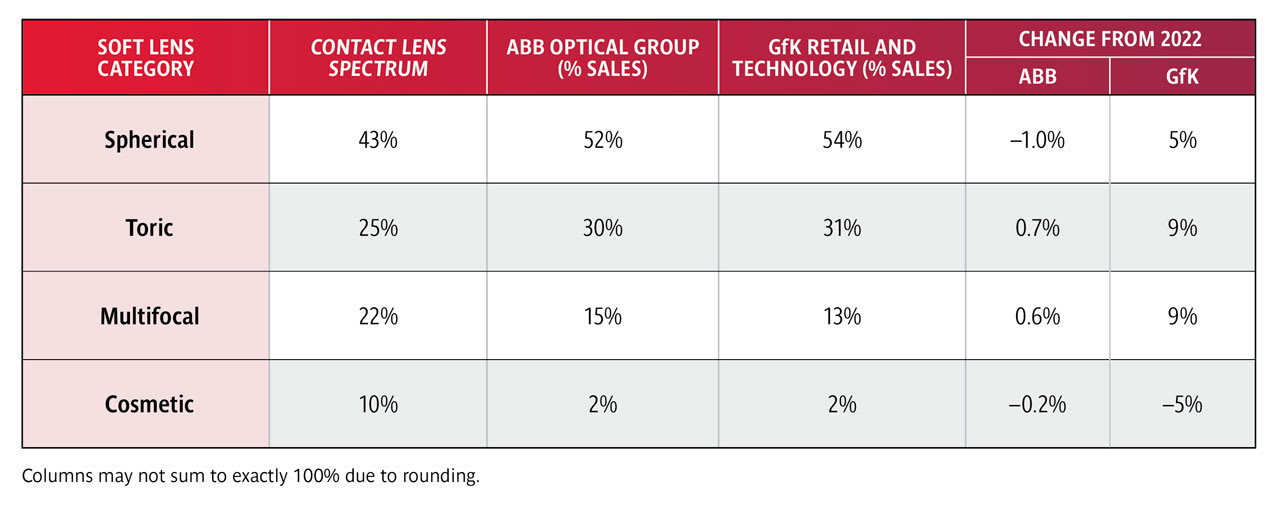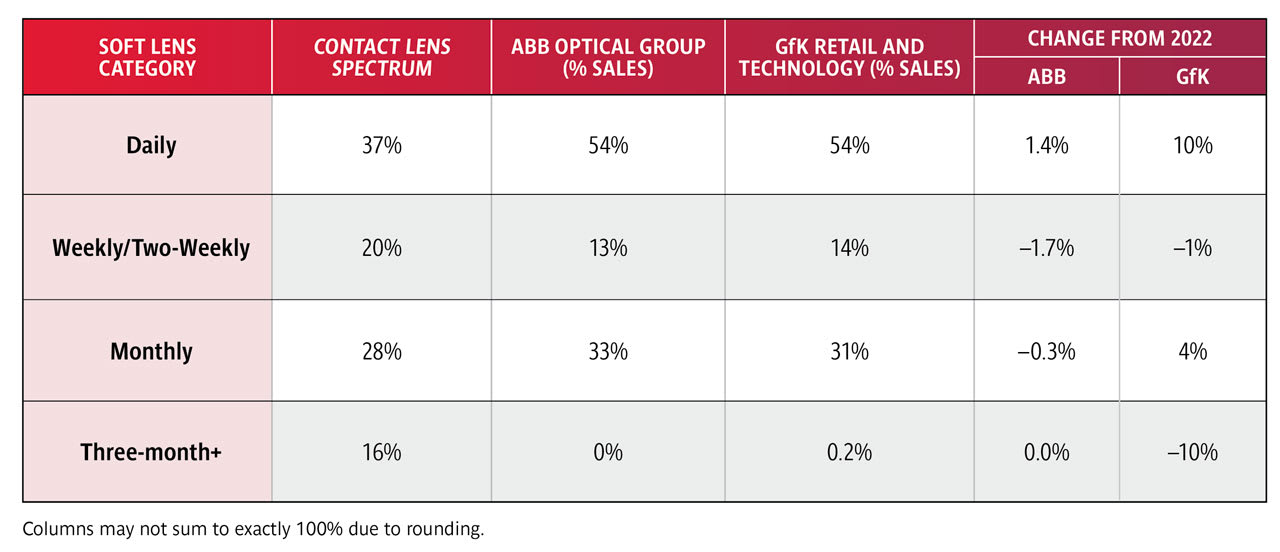

AS ANOTHER YEAR HAS COME TO A CLOSE, it is a perfect time to reflect on major events in the world and on the field of contact lenses. Although there were both ongoing and new major world conflicts, the largest-ever outbreak of monkeypox across several countries, the coronation of King Charles III, and ongoing economic and inflationary concerns, arguably the biggest news of the year was the launch of major artificial intelligence (AI) initiatives.
There is no doubt that AI will impact our lives in substantial ways, including the way we practice eye care and prescribe contact lenses. For this reason, we deemed AI to be 2023’s “event of the year.” See the editorial accompanying this edition of Contact Lens Spectrum for more details on that.
However, our purpose herein is to maintain our tradition of taking a deep dive into the contact lens market in the U.S., as we have done for over 25 years. So, here goes…
OVERVIEW OF GENERAL MARKET TRENDS
Despite another year of concerns about inflation, the health of the consumer, and continued geopolitical uncertainties, the soft contact lens market remained resilient in 2023 and delivered another year of above-normal growth. Data obtained from Baird (Jeff Johnson, OD, CFA, managing director, senior research analyst) suggests that through the first nine months of 2023, the global soft contact lens market is on track to once again grow 8% to 9% on a constant currency basis to nearly $10 billion, roughly in line with the 9% constant currency growth the market enjoyed in 2022.
A number of factors helped sustain strong momentum for the global soft contact lens market from 2022 into the early part of 2023. This year showed notable areas of growth when compared to early 2022, considering COVID disruptions that had still been weighing on contact lens demand in some international markets. Consumer confidence in the U.S. also rebounded in early 2023 and remained at relatively solid levels through much of the summer, while labor markets stayed strong throughout 2023 and helped keep a broad swath of the population with at least some level of vision care benefits in the U.S.
Two other factors contributed to the soft contact lens market’s solid performance in 2023, and they are inexorably linked. After a decade of limited price increases on like-for-like products, contact lens manufacturers started pushing 1% to 2% price increases across a number of product lines in 2022. Additionally, in 2023 these price increases on like-for-like products seemed to accelerate a bit, closer to 2% to 3% on average. With inflationary pressures on wages and other operational expenses remaining steady in 2023, many of these increases were pushed through by the big four providers to help offset higher manufacturing costs.
The other factor that drove contact lens average prices higher in 2023 was new product launches, especially in specialty categories such as torics, multifocals, and multifocal torics. With many of these specialty torics and multifocals being offered in daily disposable franchises, the benefits of trading wearers up from non-dailies to dailies, and from spherical lenses to torics and/or multifocals remained sizable in 2023, and likely had more impact than the industry had seen in many years.
Moving deeper into 2023, however, questions did start to grow about the health of consumers, both in the U.S. and across a number of international markets. While the global soft contact lens market has historically proven defensive, daily disposables represent nearly 60% of the market today (by dollars, closer to 35% to 40% by wearers), up from ~35% in 2008 to 2009. The use of premium-priced torics and multifocals has also grown, with torics and multifocals today representing over 25% and 10%, respectively, of the $10 billion global soft contact lens market versus ~15% and 5%, respectively, in 2008-2009.
That creates at least some risk in early 2024 that daily wearers might be tempted to extend the use of their daily lenses to two or three days instead of sticking to single-day use, or they might trade back down in the short run from a specialty lens to a sphere if macroeconomic conditions worsen and consumer confidence and spending trends take a sizable hit. For now, that risk doesn’t feel significant, but it is something to be watched closely. More often than not, though, the contact lens market weathers modest storms, and with new product innovation and pricing still solid, chances seem good that 2024 will be another good year for the global soft contact lens market.
CURRENT PRACTICE TRENDS
Contact Lens Spectrum also conducts market research in which our readers are asked about their practice trends and patterns, both generally and as they relate specifically to contact lenses. We have conducted this market research for many years, which allows for some longer term and longitudinal analyses. The questions cover a variety of topics, including characteristics of the patient base of a practice, business and financial aspects of a practice, and prescribing trends.
This year, we had 76 U.S. respondents complete the majority of the survey. As I discuss trends and observations about the contact lens field, I will draw on information gleaned from this market research and other sources. It is important to note that practitioners who read Contact Lens Spectrum likely reflect a sharper focus on specialty lenses compared with other data sources.

Practice and Business Trends Table 1 summarizes trends in practice and business characteristics from 2013 to 2023. Most of our respondents are optometrists, followed by ophthalmologists, contact lens technicians, and opticians. The patient base of the typical practice was made of approximately 37% contact lens wearers, and the average number of contact lens fittings and refittings in a typical week was about 23.
Practitioners estimate that 56% of their patients purchase contact lenses from their practice (50% in 2022), whereas 23% purchase their contact lenses online (23% in 2021), 14% purchase their lenses through a third-partyretailer independent of a practice, and 6% purchasetheir contact lenses from another practice setting.
Further, 59% of practitioners believe that they will see an increase in their overall contact lens practice in 2024 (versus 70% for 2023), while 35% believe that it will stay the same (versus 25% for 2023) and 5% indicate that it will be decreasing further (versus 5% for 2023). This downturn in optimism likely reflects other more broad concerns about the economy, such as inflation.
Lens Dispensing and Mode of Wear Trends As we have reported in years past, silicone hydrogel materials make up most of the fits and refits that are conducted today (Contact Lens Spectrum market data). For 2023, silicone hydrogels are being reported in usage at 50% while hydrogels were reportedly used in 29% of fits, and GPs were reportedly used across 11% of fits.
As shown in Figure 1, data from Contact Lens Spectrum’s market research showed that across all contact lens designs, most of the reported fits and refits are with soft spherical lenses (38% versus 30% in 2022), followed by soft toric lenses (21% versus 16% in 2022), soft multifocal lenses (15% versus 12% in 2022), spherical corneal GPs (9%, the same as in 2022), and scleral designs (7% versus 5% in 2022).

Along these same lines, when asked about the greatest growth potential of several popular specialty lens options in 2024, most practitioners indicated orthokeratology (ortho-k) (33%, compared to 39% for 2023), followed by scleral lenses (32%, compared to 34% for 2023), custom soft lenses (25%, compared to 17% for 2023), and hybrids (9%, compared to 10% for 2023).
When practitioners were asked to estimate the distribution of lenses by category of lens design for lenses containing any rigid GP lens material, it is perhaps not surprising that corneal designs made up the bulk of responses (56% versus 50% for 2022), followed by sclerals (18% versus 21% for 2022), ortho-k (17%, which was the same for 2022), and hybrids (9% versus 13% for 2022).
Data obtained from the ABB Optical Group (an independent optical industry platform) and GfK Retail and Technology (a market research service) showed a similar trend for 2023 when comparing what are considered the four major soft lens categories (spherical, toric, multifocal, and cosmetic). Predictably, spherical soft lenses maintained the most market share, followed by toric, multifocal, and cosmetic lenses (Table 2).
In addition to the Contact Lens Spectrum Reader Profile Survey, market insights were also gleaned from ABB Optical Group and GfK Retail and Technology in terms of replacement schedule usage (Table 3). When comparing the data sources, stable trends emerge—that is, for all three sources, the daily disposable modality continues to lead in terms of prescribing by soft lens replacement schedule (range of 37% to 54%) followed by the monthly category (range 28% to 33%) .


As has been the case for several years now, for presbyopic patients who wear contact lenses, most practitioners continue to indicate a preference for multifocal lenses (59% in 2023, compared to 50% in 2022) compared with monovision (26% in 2023, compared to 26% in 2022), and over-spectacles (14% for 2023 and 19% for 2022).
Myopia management with contact lenses is certainly a growing practice in the contact lens community. In 2023, 64% of Contact Lens Spectrum Reader Profile respondents indicated that they actively practice myopia management with contact lenses (compared with 75% in 2022, 48% in 2021). Of those who are practicing myopia management with contact lenses, most are using a soft multifocal (57%) compared with ortho-k (37%) or corneal GP multifocals (6%).
LOOKING BACK, TAKING STOCK, AND LOOKING FORWARD
As in past years, we wrap up our annual report with a look back at the contact lens industry from a decade ago. Additionally, we will look forward and offer some predictions as to where we see the industry heading.
One area in which the contact lens industry has seen a significant shift is in the area of replacement schedules. In 2013, Contact Lens Spectrum’s market research indicated that a small majority of patients were using monthly replacement schedules (44%).1 Also that year, two-week replacement schedules were reported for 30% of wearers and daily disposables only represented 20% of fits and refits (this was a gain from the 17% in 2012 and the 11% in 2009).
In 2023, these percentages flipped around quite a bit. Following continued growth, daily disposables now lead, according to the data reported earlier that showed those lenses are being used by between 37% and 54% of patients. Monthly replacements have dropped to as low as 20% according to Contact Lens Spectrum data, and two-week replacement schedules trail with reported values of 13% to 20%.
In 2013, the Tear Film & Ocular Surface Society (TFOS) International Workshop on Contact Lens Discomfort (CLD)2was named Event of the Year. The knowledge gained during the workshop was described as “a critical step forward by the contact lens community in making progress” in our understanding of contact lens discomfort.
This past April, TFOS once again pushed industry education forward with a global workshop report titled “A Lifestyle Epidemic: Ocular Surface Disease.”2 These papers tackled the often-adverse effects that lifestyles have on our health in general and the ocular surface specifically.
On the legislative and regulatory front, 2023 saw the Federal Trade Commission and the U.S. Food and Drug Administration (FDA) enforce various actions including sending cease and desist letters to prescribers failing to comply with the Contact Lens Rule and warning letters to firms manufacturing or marketing unapproved ophthalmic drug products, product recalls, and consumer warnings about potentially harmful eye drops.
There was also a push on several fronts again this year in the area of myopia. Global highlights from this past year were a report from the Australia and New Zealand Child Myopia Working Groups,4 a myopia management standard of care pledge,5 a third series of myopia whitepapers,6 and a myopia consensus statement.7 This will continue going into the next year and beyond as the National Academies of Sciences, Engineering, and Medicine has proposed to conduct a consensus study to assess the current mechanistic understanding of myopia pathogenesis and the causes of its increased prevalence, to identify knowledge gaps and barriers to progress, and to develop a research agenda aimed at better understanding the biological and environmental factors that could explain its increasing incidence.
Finally, as mentioned earlier, AI has grabbed a lot of headlines this past year. Even the federal government is getting in the fray with the formation of the FDA Digital Health Advisory Committee. While AI is not new in eye care, we are learning more and more about the potential benefits and pitfalls of this technology. And, because we are sure that AI technology is here to stay, Contact Lens Spectrum is debuting a new column this month titled “AI in Practice.” Check out page 40 for the inaugural article.
As all of these topics are ongoing, practitioners and consumers alike will have to keep their eyes open to see how it all plays out over the next year. CLS
References
1. Nichols JJ. Contact Lenses 2013. Contact Lens Spectrum. 2014 Jan;29:22-28.
2. Tear Film & Ocular Surface Society (TFOS). TFOS International Workshop on Contact Lens Discomfort (CLD). 2013. Available at tearfilm.org/dettreports-tfos_international_workshop_on_contact_lens_discomfort_cld/7260_7249/eng. Accessed 2023 Dec 5.
3. TFOS. TFOS Lifestyle Reports. 2023. Available at tearfilm.org/conferences-lifestyle_report/7374_7374/eng. Accessed 2023 Dec 5.
4. The Australia and New Zealand Child Myopia Working Group. The Australia and New Zealand Child Myopia Report 2022/23. Available at optometry.org.au/wp-content/uploads/National_news_images/2022/November/Reducing-the-Risk-to-Vision_Myopia-Report-202223.pdf. Accessed 2023 Dec 6.
5. World Council of Optometry. Myopia Management Pledge. Available at myopia.worldcouncilofoptometry.info/myopia-management-pledge. Accessed 2023 Dec 6.
6. International Myopia Institute. IMI White Papers. Available at myopiainstitute.org/imi-white-papers-clinical-summaries. Accessed 2023 Dec 6.
7. World Society of Paediatric Ophthalmology and Strabismus. Myopia Consensus Statement 2023. Available at wspos.org/wp-content/uploads/2023/06/WSPOS-Myopia-Consensus-Statement-2023.pdf. Accessed 2023 Dec 6.



